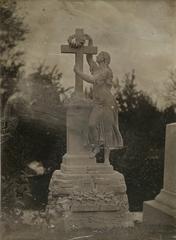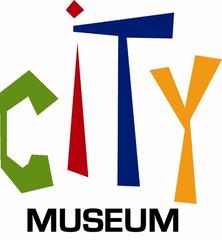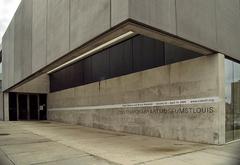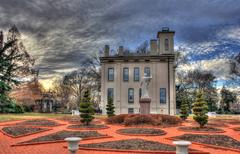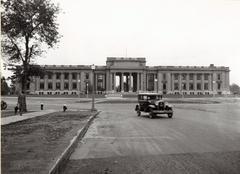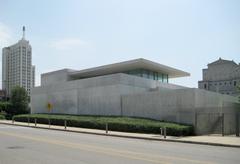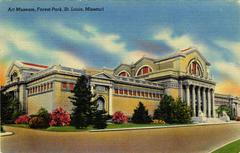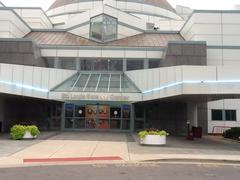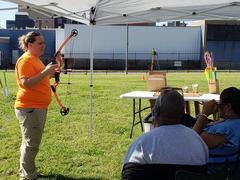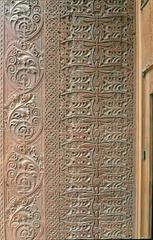
Saint Louis University Visiting Hours, Tickets, and Historical Sites Guide
Date: 03/07/2025
Introduction to Saint Louis University and Its Significance
Saint Louis University (SLU), located in St. Louis, Missouri, is an institution steeped in history, academic excellence, and Jesuit tradition. Established in 1818, it is distinguished as the first institution of higher learning west of the Mississippi River, boasting over two centuries of educational leadership and cultural impact (SLU Timeline; Encyclopedia.com). SLU’s evolution from a small academy to a major research university with global reach reflects its commitment to intellectual rigor, social justice, and community engagement.
The campus itself is a vibrant blend of historic architecture and contemporary facilities, featuring landmarks such as St. Francis Xavier College Church and the Edward A. Doisy Research Center, as well as lush green spaces and rich cultural venues. Whether you are a prospective student, a history enthusiast, or a tourist, SLU offers a unique and fulfilling visitor experience (SLU Campus Overview; Wikiwand).
This comprehensive guide equips visitors with essential information on SLU’s visiting hours, guided tours, ticketing, accessibility, and nearby attractions. Using targeted keywords such as “Saint Louis University visiting hours,” “SLU tickets,” and “St. Louis historical sites,” visitors can efficiently plan their trip and make the most of their time on campus (SLU Admissions Visit Page; SLU Events Calendar; Explore St. Louis).
Historical Overview
Founding and Early Development (1818–1832)
SLU traces its origins to November 16, 1818, when classes began in a private residence under the guidance of Bishop Louis William Valentine DuBourg. Initially named Saint Louis Academy, it welcomed a small cohort of students who benefited from a substantial 8,000-volume library (SLU Timeline; Encyclopedia.com; Wikipedia).
The academy’s progressive stance on accepting non-Catholic students and its rigorous curriculum set it apart from contemporaries. In 1820, it became Saint Louis College, and by 1827, the Society of Jesus (Jesuits) took leadership, with Father Peter J. Verhaegen as the first Jesuit president (Wikipedia; SLU Timeline).
Charter and Expansion (1832–1867)
SLU received its formal university charter in 1832, becoming the first university west of the Mississippi. It rapidly expanded, awarding the first medical degrees in the region in 1836 and relocating to a new site to accommodate growing enrollment (Encyclopedia.com; U.S. History). The establishment of St. Francis Xavier College Church in 1841 further anchored the university’s presence (Wikiwand).
Relocation and Campus Development (1867–20th Century)
By 1867, SLU moved to its current Midtown location at Grand and Lindell Boulevards, fostering decades of growth. The north campus (Frost Campus) became the academic and student life hub, while the south campus developed as a center for health sciences and medicine (St. Louis Review; Wikipedia; Wikiwand).
Social Progress and Inclusion
SLU played a pioneering role in social progress. In 1944, under the leadership of Father Claude Heithaus, S.J., the university became one of Missouri’s first historically white institutions to admit African American students (University News). The College of Arts and Sciences became coeducational in 1949, opening doors to women (St. Louis Review).
Modern Growth and Global Reach
SLU’s modern era has been marked by significant expansion, including the development of the Frost Campus, the opening of the Madrid campus in 1967, and the construction of the Edward A. Doisy Research Center (St. Louis Review; Wikipedia; Wikiwand). SLU is now classified as an “R1: Doctoral Universities – Very High Research Activity” institution, reflecting its national and international impact.
Campus Landmarks and Traditions
Iconic sites include the St. Francis Xavier College Church, the Joseph G. Lipic Clock Tower Plaza, and the Billiken statue—a symbol of good luck and university spirit (Wikiwand). Events like the OccupySLU demonstration in 2014 and Make A Difference Day underscore SLU’s deep-rooted commitment to social justice and service (St. Louis Review).
Leadership and Jesuit Identity
While lay leadership now guides SLU, its Jesuit mission continues to inform academics and community life. The university’s first permanent lay president, Fred P. Pestello, was appointed in 2014 (St. Louis Review). Jesuit values remain central to SLU’s mission and daily life (SLU History; Wikiwand).
Enrollment and Academic Profile
In the 2023–2024 academic year, SLU enrolled over 15,000 students from all 50 U.S. states and 96 countries. The university offers nearly 100 undergraduate and 140 graduate programs, with strengths in research, health sciences, and the liberal arts (Wikipedia; SLU About).
Legacy and Significance
SLU’s two-century legacy as a leader in education and social progress makes it a pillar of higher learning and a key part of St. Louis’s cultural and historical fabric (SLU Timeline; St. Louis Review).
Visiting Saint Louis University: Hours, Tickets, and Attractions
Visiting Hours and Admission
- Campus Grounds: Open to visitors daily, generally from 7:00 AM to 10:00 PM.
- Buildings: Academic and administrative buildings are open weekdays, 8:00 AM–6:00 PM. Museum and church hours may differ (see below).
- Admission: There is no general fee to visit the campus grounds. Some events or exhibitions may require tickets.
Guided Tours and Visitor Information
SLU offers guided campus tours led by student ambassadors, covering academic buildings, historic landmarks, and student life. Register for tours via the SLU admissions site. Virtual tours are also available for remote exploration.
Key Attractions and Photographic Spots
- St. Francis Xavier College Church: Gothic Revival architecture with beautiful stained glass.
- Samuel Cupples House and Gallery: Romanesque mansion and art gallery (Cupples House).
- Saint Louis University Museum of Art (SLUMA): Rotating exhibitions in a Beaux-Arts building (SLU Museums).
- Museum of Contemporary Religious Art (MOCRA): Focused on interfaith contemporary art (Explore St. Louis).
- Joseph G. Lipic Clock Tower Plaza: Iconic gathering place and social hub.
- Billiken Statue: Beloved mascot and photo spot.
Accessibility and Amenities
SLU is ADA-compliant, with accessible entrances, restrooms, and pathways. Visitors with special needs can contact the Office of Disability Services in advance. Campus amenities include Wi-Fi, cafes, dining halls, and rest areas.
Transportation and Parking
- Visitor Parking: Available in multiple garages and lots. Daily passes can be purchased at kiosks or online (SLU Parking Services).
- Public Transit: MetroLink and MetroBus serve stops near campus.
- Shuttle Services: Provided for select events and to nearby hotels.
Events and Special Programs
SLU hosts public lectures, performances, athletic events, and festivals year-round. For schedules and ticketing, consult the SLU Events Calendar.
Exploring the Campus and Surrounding Area
Campus Layout
SLU’s 271-acre urban campus is pedestrian-friendly, with key landmarks and green spaces organized around central plazas. The North Campus houses most academic and cultural buildings, while the South Campus focuses on health sciences.
Museums and Cultural Attractions
- SLUMA: Open Tuesday–Saturday, 10:00 AM–4:00 PM. Free admission; special events may require tickets.
- MOCRA & Cupples House: Feature unique art collections and historic exhibits.
Dining and Lodging
- On Campus: Dining halls and cafes cater to all tastes, including chain options like Starbucks and Panera (SLU Campus Overview).
- Nearby: Midtown and Central West End offer diverse dining and convenient hotels (e.g., AC Hotel St. Louis CWE, Sonesta Chase Park Plaza).
Nearby Historical Sites
SLU’s central location provides easy access to St. Louis attractions such as:
- Gateway Arch: Iconic monument with museum and observation tram.
- Forest Park: Home to the Saint Louis Zoo, Missouri History Museum, and Art Museum.
- City Museum: An interactive urban playground.
- Missouri Botanical Garden: Renowned for its historic landscapes (Explore St. Louis).
Frequently Asked Questions (FAQ)
Q: What are Saint Louis University’s visiting hours?
A: Campus grounds are open daily from 7:00 AM to 10:00 PM; building and museum hours vary.
Q: Is there an admission fee?
A: General campus access is free; some events and museum exhibitions may require tickets.
Q: Are guided tours available?
A: Yes, guided, self-guided, and virtual tours can be booked via the SLU admissions site.
Q: Where do I park?
A: Visitor parking is available in designated lots and garages; see SLU Parking Services for details.
Q: Is the campus accessible?
A: Yes, SLU offers ADA-compliant facilities and accommodations.
Q: How can I get tickets for events?
A: Event tickets are available through the SLU Events Calendar.
Visitor Tips and Recommendations
- Check hours and event schedules in advance, especially during holidays or special occasions.
- Register for guided tours to enhance your visit and gain insider perspectives.
- Download the Audiala app for interactive maps, audio tours, and real-time updates.
- Explore nearby St. Louis attractions to enrich your experience.
Summary
Saint Louis University combines historic significance, academic distinction, and vibrant campus culture in one of St. Louis’s most accessible urban settings. Its rich Jesuit heritage and commitment to inclusivity create a welcoming environment for all visitors. With diverse museums, beautiful architecture, and a central location near major city attractions, SLU stands as an essential destination for students, history lovers, and travelers alike (SLU History; SLU Parking Services; SLU Campus Overview; Explore St. Louis).
For the latest information, consult the official SLU website or the SLU Admissions Visit Page.
Sources and Further Reading
- SLU Timeline, 2023, Saint Louis University
- Encyclopedia.com, Saint Louis University entry
- Wikipedia, Saint Louis University, 2024
- St. Louis Review, A Bishop’s Efforts Led to Origins of Saint Louis University
- SLU Campus Overview, 2024
- Wikiwand, Saint Louis University article
- SLU Admissions Visit Page
- SLU Events Calendar
- SLU Parking Services
- Explore St. Louis, 2024

